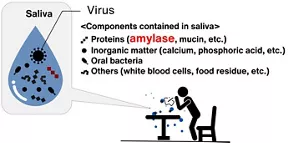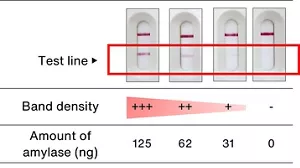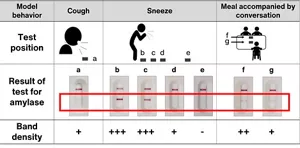Solutions for Preventing Infection in Institutional Environments Based on a New Hygiene Inspection Method
Hygiene Science
Contact infection is considered to be one of infection routes for COVID-19, influenza, and other infectious diseases. What happens is this: an infected person’s saliva droplets containing the virus adhere to an object, and an uninfected person comes in contact with it, brings the virus into the body, and then becomes infected.
Preventing infection involves keeping the surrounding environment hygienic and cutting off infection routes. Nowadays there is demand for simple ways to identify places contaminated with viruses for efficient hygiene control.
Many viruses are dispersed from the body together with saliva from infected people.

We considered employing immunochromatography, which uses antigen-antibody reactions, as a way to visually determine the amount of amylase, which is contained in saliva in high concentrations, present on the surfaces of an environment.
Before and after the test subjects did certain actions that disperse saliva (coughed, sneezed, and ate a meal), plates placed around the subjects were tested for amylase. Amylase was subsequently detected on the plates placed near the subjects, which were predicted to be contaminated with saliva droplets, and not detected on the plates placed away from the subjects.


It is important to wipe surfaces with a disinfectant or the like to prevent places where hygiene is crucial from being contaminated with saliva droplets from infected people. We will apply the findings of this study to methods that contribute to efficient hygiene control.
- Home
- Innovation
- Research & Development
- Product Development Research
- Fabric and Home Care
- Solutions for Preventing Infection in Institutional Environments Based on a New Hygiene Inspection Method
- Home
- Innovation
- Research & Development
- Product Development Research
- Fabric and Home Care
- Solutions for Preventing Infection in Institutional Environments Based on a New Hygiene Inspection Method
